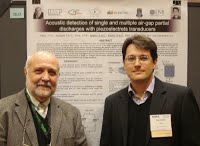Acoustic detection of single and multiple air-gap partial discharges with piezoelectrets transducers
 Electrical equipment installed in power transmission and distribution lines are usually subjected to abnormal conditions and intense electric fields, which eventually lead, among others phenomena, to partial discharges (PD). These, have been pointed as one of the main causes of equipment failures and premature aging. Therefore, detect PD became an important issue in the prospect of efficient and reliable electric energy. Concerning PD detection there are several sensors that can be employed e.g. optical, magnetic or acoustic, and each of them presenting particular advantages and limitations. One of the drawback of such sensors are their elevated costs for transmission lines equipments, which has restrict the PD monitoring to power transformers. Although, if the intention is only to detect the PD occurrence a new class of acoustic sensors implemented with piezoelectrets may be a feasible economic alternative. Therefore, in this work we have investigated the acoustic behavior of such transducers exposed to different PD conditions, for instance, the piezoelectret sensor was employed on the detection of PD produced by a single or multiple point-to-point electrode setup with different air gaps driven by high AC voltages. The recorded signals amplitudes were than correlated with the gap distance and voltage amplitude.
Electrical equipment installed in power transmission and distribution lines are usually subjected to abnormal conditions and intense electric fields, which eventually lead, among others phenomena, to partial discharges (PD). These, have been pointed as one of the main causes of equipment failures and premature aging. Therefore, detect PD became an important issue in the prospect of efficient and reliable electric energy. Concerning PD detection there are several sensors that can be employed e.g. optical, magnetic or acoustic, and each of them presenting particular advantages and limitations. One of the drawback of such sensors are their elevated costs for transmission lines equipments, which has restrict the PD monitoring to power transformers. Although, if the intention is only to detect the PD occurrence a new class of acoustic sensors implemented with piezoelectrets may be a feasible economic alternative. Therefore, in this work we have investigated the acoustic behavior of such transducers exposed to different PD conditions, for instance, the piezoelectret sensor was employed on the detection of PD produced by a single or multiple point-to-point electrode setup with different air gaps driven by high AC voltages. The recorded signals amplitudes were than correlated with the gap distance and voltage amplitude.
Unipolar ferroelectrets – Following the example of the electret microphone more closely
 We report first investigations on a ferroelectret transducer material that is based on the same layer sequence as a simple electret microphone. Only one electrically charged polymer film is employed instead of two as in previous tubular-channel ferroelectrets. The new materials design has major advantages such as a reduced number of polymer films to be processed and a reduced amount of expensive electret material, as well as the possibility to choose the polarity of the charged layer for optimal stability. A drawback seems to be a lower piezoelectric coefficient, since the values obtained in our preliminary experiments amount to roughly half of those found on bipolar ferroelectrets made from two polymer-electret films. Nevertheless, the d33 values observed on our samples are still twice as high as those of polyvinylidene fluoride (PVDF) and can be further improved, e.g. through modifications of the ferroelectret geometry, the layer sequence and the electret properties or via multi-layer stacking as already demonstrated for polypropylene piezoelectrets.
We report first investigations on a ferroelectret transducer material that is based on the same layer sequence as a simple electret microphone. Only one electrically charged polymer film is employed instead of two as in previous tubular-channel ferroelectrets. The new materials design has major advantages such as a reduced number of polymer films to be processed and a reduced amount of expensive electret material, as well as the possibility to choose the polarity of the charged layer for optimal stability. A drawback seems to be a lower piezoelectric coefficient, since the values obtained in our preliminary experiments amount to roughly half of those found on bipolar ferroelectrets made from two polymer-electret films. Nevertheless, the d33 values observed on our samples are still twice as high as those of polyvinylidene fluoride (PVDF) and can be further improved, e.g. through modifications of the ferroelectret geometry, the layer sequence and the electret properties or via multi-layer stacking as already demonstrated for polypropylene piezoelectrets.
